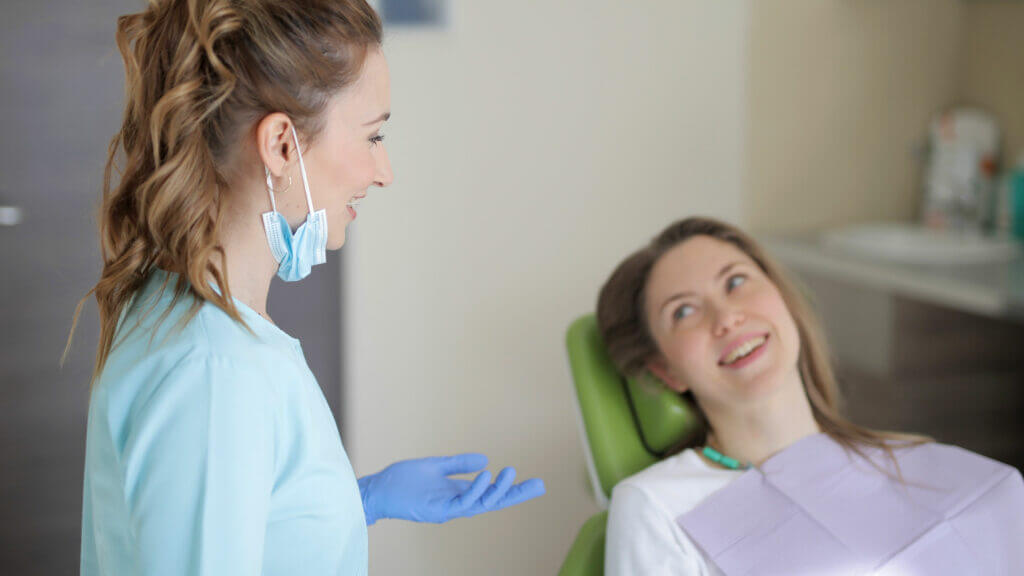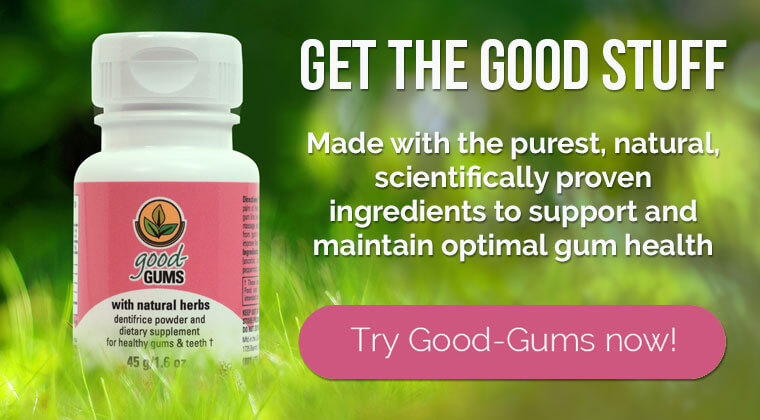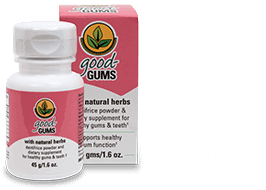GROW & SUPPORT HEALTHY NEW GUM CELLS WITH GOOD-GUMS
Part 1 of our series of Reference Articles explaining the proven science behind the Good-Gums, how it works so well, and why. Read Article 2 – Read article 3.
Ingredients in the Good-Gums formula have scientifically proven beneficial effects for oral health which have been established and confirmed by a number of clinical trials, studies and peer-reviewed scientific articles. The formula is specifically designed so that all our ingredients work in concert for maximum effectiveness in tackling a range of gum issues including gum disease, bleeding gums, infected gums & periodontitis, receding gums and the restoration of gum tissue.

THE SCIENCE BEHIND HOW THE GOOD-GUMS FORMULA SUPPORTS THE GROWTH OF NEW HEALTHY GUM CELLS
Unique to Good-Gums is the most important support for the growth of healthy new gum cells, which is critical when we’re faced with improving the health of gums that are already compromised. That support comes from vitamin C and from other carefully-selected ingredients that help the gums get maximum benefit from the vitamin C.
Good-Gums is packed with vitamin C – the most crucial nutrient to support the biological mechanism of producing healthy gum tissue cells, and the vitamin C is delivered in a way that protects the enamel from its acidity, while also enhancing the effectiveness of this critical vitamin.
Your body needs to grow healthy gum cells when your gums become infected and need to be healed, when gum disease has killed off gum tissue cells, and also when gum cells reach the end of their natural lifespan and need to be replaced by healthy new gum cells. As shown by studies below, your gum tissue absolutely relies on large amounts of vitamin C within the gums in order to restore and maintain its health. Citations for the sources of the following information are indicated by numbers parentheses in the text of the bullet points below.
- The gums are made of connective tissue. (1), (2)
- The connective tissue of gums is comprised of the protein collagen. (3), (4), (5), (6), (7)
- Collagen and the resulting gum cells are produced right in the gums, right where healthy new gum cells are needed. Collagen and the connective tissue cells are produced in organs throughout the body, wherever connective tissue cells are needed; their production is not limited to just one specific collagen-producing organ. (8), (9), (10),(11), (12), (13)
- Vitamin C at the site of gum cell creation is absolutely essential to your body’s ability to produce and to cross-link the collagen protein that makes up the connective tissue of your gums. Conversely, a lack of vitamin C leads to serious gum diseases, such as periodontal disease (the death of gum tissue cells) and gum recession (the reduction in the volume of gum tissue when enough gum cells have been killed). (14), (15), (16), (17), (18)
- Absorbing vitamin C only through the stomach and intestines provides little to the gums, even when a rapid and intensive growth of healthy gum cells is required. Fortunately the gums are very absorptive and can absorb the needed vitamin C directly where it’s needed the most to create the building blocks of healthy new gum cells, thereby supporting your gum health. In fact, absorption by the gums is so efficient that it is generally considered a faster route than absorption by the stomach and intestines for drugs whose quick absorption is critical (such as nitroglycerin for a heart attack victim). (19), (20), (21) This property of efficient absorption by the gums is leveraged by Good-Gums to concentrate within the gums the help needed by gums that are in distress.
- Vitamin C, by itself, is quite acidic, enough to be harmful to enamel, so putting vitamin C by itself in your mouth is a bad idea. But buffering the acidity of vitamin C with a natural alkaline ingredient protects the enamel from vitamin C’s acidity. (22) Of all the ingredients in Good-Gums, the ingredient with the highest amount is the alkaline baking soda. Not only does it buffer the acidity of the vitamin C, but it also makes the pH of the mouth less hospitable for the acid-loving bacteria that create both plaque and calculus, and that also infect the gums.
- It’s not enough to put an alkaline ingredient (baking soda) in the same bottle as an acidic ingredient (the essential vitamin C). They must be prevented from reacting with each other in the bottle, or else the reaction would render the vitamin C powerless. That’s why Good-Gums is delivered as a dry powder, free of any liquid (such as water) that otherwise would act as an electrolyte / catalyst for the alkaline and acidic ingredients to react. Dry powder = no electrolyte = inhibition of reaction between baking soda and vitamin C = no degradation of the vitamin C. (23) The particles of all the ingredients are sized to dissolve instantly in saliva, forming a liquid solution rich in vitamin C (with its acidity buffered) that can be absorbed directly by the gums, before the vitamin C can be degraded.
- Citrus bioflavonoids in the Good-Gums formula help the body to use vitamin C more efficiently. (24), (25), (26) Their inclusion in Good-Gums ensures that your gums get the most benefit from the formula’s vitamin C.
- Gum cells have very short lifespans and extremely fast replacement rates. The beauty of this arrangement is that the cells forming the gums (and especially the lining of the gums) can expend themselves in their relentless encounter with microbes (bacteria, viruses, fungi, spores, etc.) that enter the mouth from the environment via food or water or the air that’s breathed in. To keep these defenses up to the task, fresh new cells replace the older ones that expire in only a few days (unlike the cells of most organs that typically last many months or even years). (27), (28), (29) The implications of the fast turnover rate of gum cells are that your gum tissue can recover relatively quickly. When it involves cells that are infected or inflamed and that also get the support they need, it can be quite quickly indeed. When it involves cells that have died off, that no longer exist, and that need to be regrown as additional cells in order to increase the volume of gum tissue (as when reversing gum recession), it will take considerably longer, but even then it is still doable.

Now that you’ve gotten some insight into how important vitamin C is for the restoration and maintenance of optimal gum health, and that you know how vitamin C needs to be delivered in a very specific way in order to be effective, you can start taking control of your own oral health. So whether you want to attack gum disease, restore receding gums or tackle periodontitis, you can rest assured that Good-Gums has the power to support your healing – and that it’s backed by good science.
Purchase your first bottle now and get started.

CITATIONS – PEER REVIEWED STUDIES, REPORTS AND ARTICLES ON HOW INGREDIENTS IN GOOD-GUMS SUPPORT THE GROWTH OF HEALTHY NEW GUM CELLS
(1) Periobasics; Gingival Connective Tissue, by Dr. Nitin Saroch; Dec 2019; https://periobasics.com/gingival-connective-tissue/
(2) Gingiva/Gingivae, Encyclopedia Britannica; https://www.britannica.com/science/gum-anatomy
(3) Analysis of Collagen Fibers in Human Gingival Tissues Using Picrosirius Red Stain Under Polarized Microscope, by Anu Chnadran, Rahul BhandRY, Nina Shenov and Urvashi Ashwin Shetty, 2021. https://www.ncbi.nlm.nih.gov/pmc/articles/PMC8041084/
Excerpt: Collagen fibers are the main element of gingival connective tissue and contribute a leading role in the preservation of structural integrity and tissue function. Hence its degradation is regarded as the main marker of periodontal disease progression.
(4) Periobasics; Gingival Connective Tissue, by Dr. Nitin Saroch; Dec 2019; https://periobasics.com/gingival-connective-tissue/
Excerpt: The connective tissue of the gingiva is termed the lamina propria. It is densely collagenous with a few elastic fibers.
(5) Collagen; Encyclopedia Britannica; https://www.britannica.com/science/collagen
(6) Does Collagen Help Your Teeth and Gums?, https://www.thecollagen.co/blogs/news/does-collagen-help-your-teeth-and-gums
(7) Collagen; The Cleveland Clinic; https://my.clevelandclinic.org/health/articles/23089-collagen
(8) Biochemistry, Collagen Synthesis; by Marilyn Wu, Kelly Cronin, Jonathan S. Crane; 2021; https://www.ncbi.nlm.nih.gov/books/NBK507709/
(9) Fibrolast; The National Institutes of Health; National Human Genome Research Institute; Fibrolast; 2022; https://www.genome.gov/genetics-glossary/Fibroblast
(10) Periobasics; Gingival Connective Tissue, by Dr. Nitin Saroch; Dec 2019; https://periobasics.com/gingival-connective-tissue/
(11) Where Are Fibroblasts Found in the Body? by Liam | Oct 5, 2020; https://plasmapenuk.com/2020/10/where-are-fibroblasts-found-in-the-body/
(12) Fibrolast; Wikipedia; https://en.wikipedia.org/wiki/Fibroblast
(13) Morphological and Quantitative Study of Collagen Fibers in Healthy and Diseased Human Gingival Tissues; by Tatiane Almeida , Thalita Valverde, Paulo Martins-Júnior, Heder Ribeiro, Gregory Kitten, Lorenza Carvalhaes; 2015;https://pubmed.ncbi.nlm.nih.gov/25826485/
(14) Effect of vitamin C and its derivatives on collagen synthesis and cross-linking by normal human fibroblasts; N Boyera 1 , I Galey, B A Bernard; 1998; https://pubmed.ncbi.nlm.nih.gov/18505499/
Excerpt: Vitamin C (VitC) plays a critical role in the maintenance of a normal mature collagen network in humans (anti-scurvy properties) by preventing the auto-inactivation of lysyl and prolyl hyroxylase, two key enzymes in collagen biosynthesis.
(15) Does Vitamin C Help Collagen Production?; Edible Health; Vitamin C and Collagen – Everything You Need To Know; https://www.ediblehealth.com/en-se/blogs/our-blog/vitamin-c-and-collagen-everything-you-need-to-know
Excerpt: Vitamin C is vital for collagen production. However, let’s take a step back to answer this question more thoroughly. Two enzymes are essential for the production of collagen. They are: Proxyl hydroxylase, which serves to stabilize the collagen molecule, and; Lysyl hydroxylase, which gives collagen its structural strength and cross-linking features. For both these enzymes to perform, they require Vitamin C.
(16) Vit. C and Collagen Synthesis; Vitamin C in Dermatology; Indian Dermatology Online Journal. 2013 Apr-Jun; 4(2): 143–146; https://www.ncbi.nlm.nih.gov/pmc/articles/PMC3673383/
Excerpt: Vit. C is essential for collagen biosynthesis. It has been proposed that Vit. C influences quantitative collagen synthesis in addition to stimulating qualitative changes in the collagen molecule. Vit. C serves as a co-factor for the enzymes prolysyl and lysyl hydroxylase, the enzymes that are responsible for stabilizing and cross-linking the collagen molecules. Another mechanism by which Vit. C influences the collagen synthesis is by stimulation of lipid peroxidation, and the product of this process, malondialdehyde, in turn stimulates collagen gene expression.
(17) Periodontitis Is Associated with a Low Concentration of Vitamin C in Plasma; American Society for Microbiology; Clinical and Diagnostic Laboratory Immunology; Sep 2003; 897-902; https://www.ncbi.nlm.nih.gov/pmc/articles/PMC193894/
Excerpt: Vitamin C is involved in the synthesis of intercellular substances such as collagen fibers found in various forms of connective tissues
(18) How Does Vitamin C Help Produce Collagen?; Woman and Wellness; Vitamin C and Collagen Production; 2021; https://womanandwellness.com/this-is-how-vitamin-c-helps-produce-collagen/
Excerpt: The synthesis of collagen protein cannot take place unless there is vitamin C in the mix.
(19) Absorption of Vitamin C From the Human Buccal Cavity; National Library of Medicine; National Center for Biotechnology Information; Br J Nutr . 1979 Jul;42(1):15-20; https://pubmed.ncbi.nlm.nih.gov/486391/
(20) Understanding the Oral Mucosal Absorption and Resulting Clinical Pharmacokinetics of Asenapine; AAPS PharmSciTech. 2012 Dec; by Jeremy A. Bartlett and Kees van der Voort Maarschalk; https://www.ncbi.nlm.nih.gov/pmc/articles/PMC3513449/
Excerpt: Absorption of drugs from the oral cavity into the mucosal tissues is typically a fast event.
Excerpt: Systemic exposure of drugs after oral mucosal administration is often expected to be a route of administration with a fast onset of action. This expectation is in line with the fact that the time for absorption of drugs into the oral mucosal membranes is typically short,
(21) The Oral Cavity as a Site for Systemic Drug Delivery; Advanced Drug Delivery Reviews; Volume 13, Issues 1–2, January–February 1994; by Michael J.Rathbone, Bernadette K.Drummond, Ian G.Tucker https://www.sciencedirect.com/science/article/abs/pii/0169409X94900248
Excerpt: As a site for drug delivery the oral cavity offers advantages over the conventional gastrointestinal route and the parenteral and other alternative routes of drug administration. It provides direct entry into the systemic circulation thereby avoiding the hepatic first pass effect, ease of administration and the ability to terminate delivery when required. In addition the membranes that line the oral cavity are readily accessible and exhibit robustness and fast cellular recovery following local stress or damage
(22) Dental Erosion from an Excess of Vitamin C; Case Reports in Dentistry; by Priya Bahal* and Serpil Djemal; 2014; https://www.ncbi.nlm.nih.gov/pmc/articles/PMC4137695/
Excerpt: Acid erosion of enamel is the chemical dissolution of the superficial layers of teeth without the presence of bacteria. If the presence and exposure of a demineralising agent such as vitamin C is frequent and prolonged, it can lead to significant tooth wear.
Excerpt: The buffering potential of saliva and the salivary pellicle act to counteract the effects of the acidic challenge.
(23) The strength of the vitamin C in the Good-Gums formula has been tested multiple times for the retention of its strength over time by an FDA-certified cGMP facility. At the start of the Good-Gums company, samples of the product were subjected to accelerated-aging that confirmed the viable strength of vitamin C (as well as of the other ingredients) for at least three years after being manufactured. Three years later, after actual real-time aging, the 3-year-old product was again tested to determine whether the actual aging matched the accelerated aging. The strength of the vitamin C after three years was confirmed. The product was then also subjected to additional accelerated-aging to determine if it could be certified for an additional 3 years (i.e., for 6 years after being manufactured). After six years, the strength of the vitamin C had dropped to a little bit below 90% of the strength stated at the time of being manufactured, so the expiration of the shelf life was kept at three years. These tests showed that the vitamin C as a dry component of Good-Gums’s dry powder formula has such a slow degradation in the bottle over time that Good-Gums can deliver the required vitamin C when the Good-Gums is used within its stated shelf life (any time prior to its expiration date).
(24) Vitamin C & Bioflavonoids; Huntington College of Health Sciences; By Gene Bruno, MS, MHS – Dean of Academics, Huntington College of Health Sciences; 2002; https://www.huhs.edu/literature/Vitamin%20C.pdf
Excerpt: Bioflavonoids (citrus, hesperidin and rutin), sometimes called vitamin P, are substances that are found wherever vitamin C is found in nature. For example, the white material found under the skin of an orange actually contains bioflavonoids. Bioflavonoids have been shown to improve the therapeutic action of vitamin C.
(25) Ways to Absorb Vitamin C; LiveStrong; Nutrition -> Nutrition Basics -> Vitamins and Supplements; By Christine Garvin; https://www.livestrong.com/article/500915-ways-to-absorb-vitamin-c/
Excerpt: Bioflavonoids Another way to make sure your body is absorbing vitamin C is to make sure you take it with bioflavonoids. According to Dr. Robert Rountree in his book, “The New Breastfeeding Diet Plan,” flavonoids are necessary for proper vitamin C absorption and utilization.
(26) Potential Synergy of Phytochemicals in Cancer Prevention: Mechanism of Action; Journal of Nutrition; by Rui Hai Liu; 2004; https://pubmed.ncbi.nlm.nih.gov/15570057/
(27) Histology, Oral Mucosa; by Melina Brizuela, Ryan Winters; National Institutes of Health; National Library of Medicine; National Center of Biotechnology Information; 2022; https://www.ncbi.nlm.nih.gov/books/NBK572115/
Excerpt: Oral Epithelium Replenishment : The oral epithelial cells are frequently replaced by cell division, around each 14 to 21 days. This is because the oral cavity is constantly exposed to high functional demands, which necessitate frequent turnover.
Excerpt: Table 1: Turnover time of epithelial cells in selected tissues:
| Oral tissue | Average epithelial turnover time (days) |
| Buccal mucosa | 14 |
| Floor of the mouth | 20 |
| Hard palate | 24 |
(28) Gastrointestinal immunology: Cell Types in the Lamina Propria–a Morphological Review; Acta Physiologica Hungarica; 2000; 87(4):305-28.; by B Hunyady, E. Mezey and M. Pakovitz; https://pubmed.ncbi.nlm.nih.gov/11732886/
Excerpt: The majority of the cells involved in immune reactions are in the lamina propria (LP) and in the submucosa.
(29) Lamina Propria; by Jason Wasserman MD PhD FRCPC; June 9, 2022; https://www.mypathologyreport.ca/lamina-propria/
Excerpt: Lamina propria is a thin layer of connective tissue found just under the surface of most types of tissues that are exposed to the external environment. These tissues include the mouth and throat, digestive tract, and cervix. The lamina propria is a very thin layer of tissue … It is made up of long, thin supporting cells called fibroblasts, which make specialized matrix proteins that hold the tissue together. The fibroblasts are surrounded by small blood vessels and a variety of inflammatory cells that protect the body from any microbes that may try to enter the body through the surface of the tissue. In most areas of the body, the lamina propria sits directly below and supports specialized epithelial cells which form a barrier on the surface of the tissue called the epithelium.

And did you know that Good-Gums also soothes sore and inflamed gum tissue, contains natural antimicrobial herbs, contains natural anti-microbial plant extracts that loosens the grip of plaque-forming bacteria without the use of enamel eroding abrasives?
Read the other two articles in this series here:
Good Gum Science #2 – Anti-Microbial Ingredients And How They Work
Good Gum Science #3 – Tissue-Soothing Ingredients
Or visit our Reference Articles Introduction Page.


